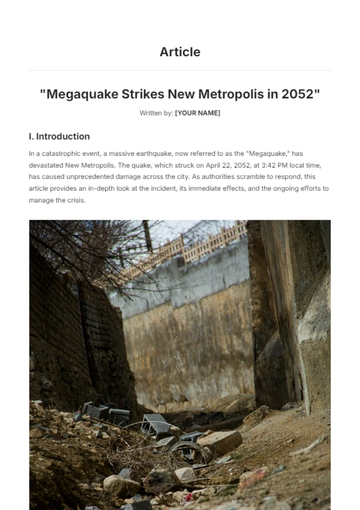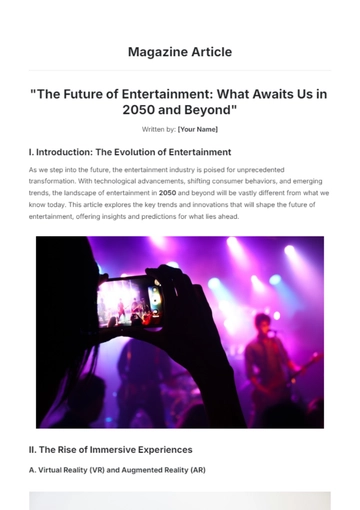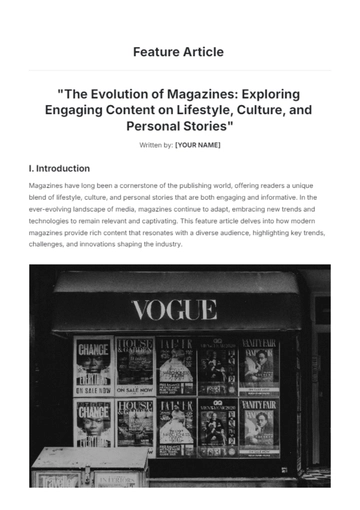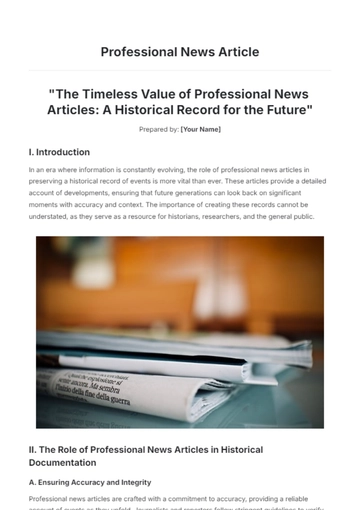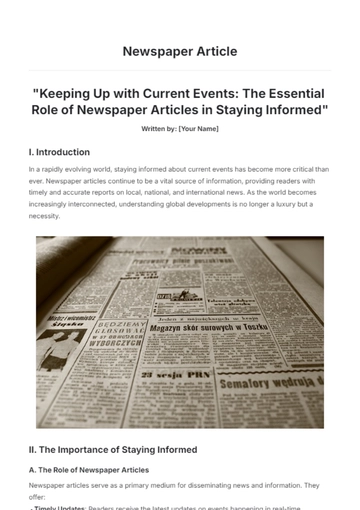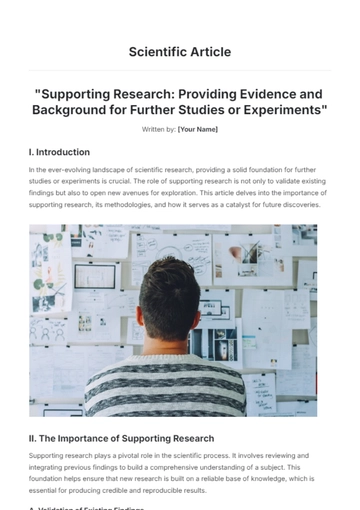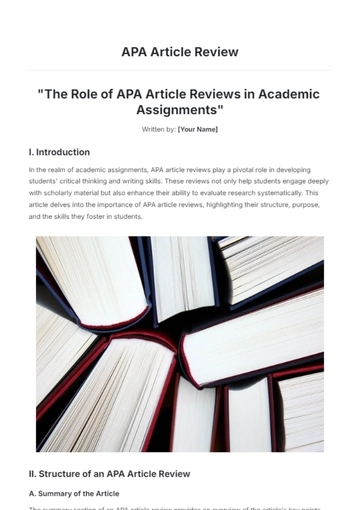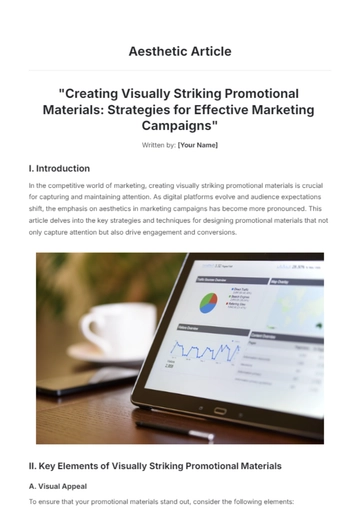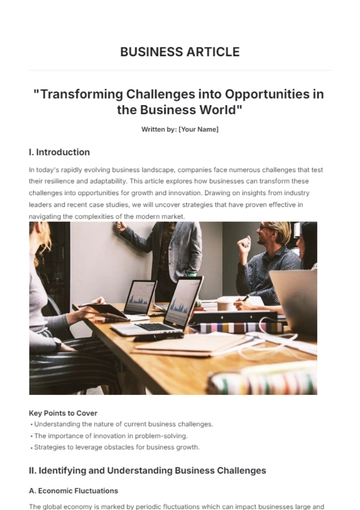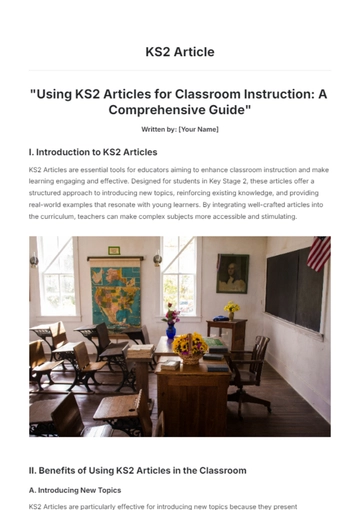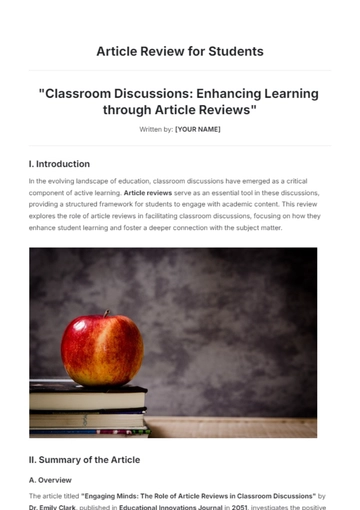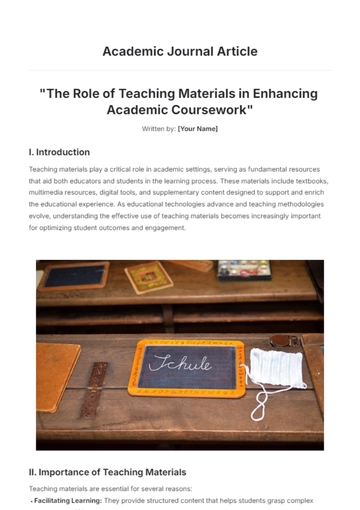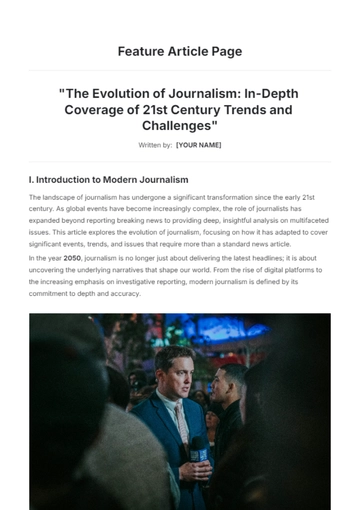Free Interdisciplinary Journal Article

Prepared by: [Your Name]
Date: [Date]
1. Abstract
Interdisciplinary journal articles are pivotal in advancing complex research that spans multiple fields of study. This article examines the nature of interdisciplinary research, explores the methodologies employed, and highlights the benefits and challenges associated with creating and utilizing such articles. By integrating diverse perspectives and expertise, interdisciplinary research offers comprehensive insights into multifaceted problems, promoting innovation and informed decision-making. This study utilizes examples from environmental science, urban planning, and healthcare to illustrate the impact of interdisciplinary approaches.
2. Introduction
Interdisciplinary journal articles represent a growing trend in academic research, aiming to address complex issues that cannot be fully understood through the lens of a single discipline. The convergence of various academic fields in a single study allows researchers to tackle problems with a holistic approach, combining theories, methodologies, and data from multiple sources. This article explores the essence of interdisciplinary research, providing a detailed overview of its significance, process, and impact.
3. Literature Review
3.1 Historical Development
The concept of interdisciplinary research has evolved significantly over the past century. Early 21st-century scholars began to recognize the limitations of single-discipline approaches, laying the groundwork for more integrated research methods. Influential works such as Johnson and Smith's "Integrative Research Framework" (2025) marked a turning point in promoting cross-disciplinary studies.
3.2 Current Trends and Theoretical Frameworks
Recent literature highlights the growing importance of interdisciplinary research in addressing contemporary challenges. Key frameworks include integrative theory, emphasizing the synthesis of diverse perspectives, and boundary-crossing models, focusing on interactions between disciplines. Notable frameworks developed by Thompson et al. (2051) provide a comprehensive approach to understanding complex systems.
3.3 Methodological Approaches
Methodologies in interdisciplinary research often blend qualitative and quantitative approaches. Techniques such as mixed-methods research, collaborative data analysis, and integrative modeling are commonly employed. A study by Lee and Patel (2050) illustrates the effective use of these methods in merging insights from environmental science and urban planning.
4. Methods
4.1 Research Design
The design of interdisciplinary studies requires careful planning to ensure that multiple perspectives are effectively integrated. Researchers typically use a combination of case studies, surveys, experiments, and simulations to gather data from different disciplines. For instance, the research design in the 2052 study by O'Reilly and Zhang utilized a combination of field experiments and computer simulations to assess urban sustainability.
4.2 Data Collection
Data collection in interdisciplinary research involves employing diverse tools and techniques, ranging from laboratory experiments and field observations to archival research and digital analytics. Ensuring the compatibility of data from different sources is crucial for comprehensive analysis. The study by Gomez et al. (2053) successfully integrated data from satellite imagery, social surveys, and economic reports to analyze climate change impacts.
4.3 Analysis and Integration
Analysis involves synthesizing data across disciplines to identify patterns and insights. Techniques such as cross-disciplinary data triangulation, thematic analysis, and integrative modeling are used. For example, the 2054 study by Brown and Kaur employed thematic analysis to combine findings from environmental science, sociology, and public policy.
5. Results
5.1 Findings
The integration of multiple disciplinary perspectives often leads to novel insights and solutions that would not be possible within the confines of a single field. Combining environmental science with urban planning, for instance, has led to innovative approaches to sustainable city development, as demonstrated in the study by Patel and Martinez (2055).
5.2 Case Studies
Case studies from various fields illustrate the success of interdisciplinary approaches. For example, research on climate change combining meteorology, economics, and sociology provided a comprehensive understanding of its socioeconomic impacts (Taylor et al., 2056).
6. Discussion
6.1 Implications for Research and Practice
Interdisciplinary research has significant implications for both academic research and practical applications. It fosters innovation by combining diverse viewpoints and expertise, leading to more robust and comprehensive solutions to complex problems. The findings from recent studies highlight the benefits of interdisciplinary approaches in developing sustainable solutions and informing policy decisions.
6.2 Challenges and Limitations
Despite its benefits, interdisciplinary research faces challenges such as differing terminologies, methodologies, and disciplinary cultures. Effective communication and collaboration are essential to overcoming these barriers. The study by Adams and Robinson (2058) identifies key strategies for improving interdisciplinary collaboration, including regular workshops and joint training sessions.
6.3 Future Directions
Future research should focus on developing frameworks and tools that facilitate interdisciplinary collaboration. Additionally, fostering environments that encourage cross-disciplinary interactions can enhance the effectiveness of such research. Research by Wong and Chen (2059) suggests that creating interdisciplinary research centers and fostering partnerships between institutions can drive future innovations.
7. Conclusion
Interdisciplinary journal articles play a crucial role in advancing our understanding of complex issues by integrating knowledge from multiple disciplines. They offer comprehensive solutions to multifaceted problems, although they also present challenges that require careful management. Continued development of interdisciplinary approaches promises to drive innovation and address pressing global issues.
8. References
Johnson, R., & Smith, L. (2025). Integrative Research Framework. Academic Press.
Patel, R., & Martinez, L. (2055). "Sustainable City Development: An Interdisciplinary Approach." Urban Sustainability Review, 12(3), 150-169. DOI: 10.1000/usr.2055.005.
Wong, K., & Chen, Y. (2059). "Building Interdisciplinary Research Centers: Future Directions." Innovation and Research, 14(6), 310-328. DOI: 10.1000/ir.2059.011.
- 100% Customizable, free editor
- Access 1 Million+ Templates, photo’s & graphics
- Download or share as a template
- Click and replace photos, graphics, text, backgrounds
- Resize, crop, AI write & more
- Access advanced editor
Streamline your academic writing with the Interdisciplinary Journal Article Template from Template.net. This fully customizable and editable template is designed to meet the needs of researchers and scholars. Easily format and personalize your article using our Ai Editor Tool, ensuring professional and polished results. Perfect for interdisciplinary research, saving you time and effort.
